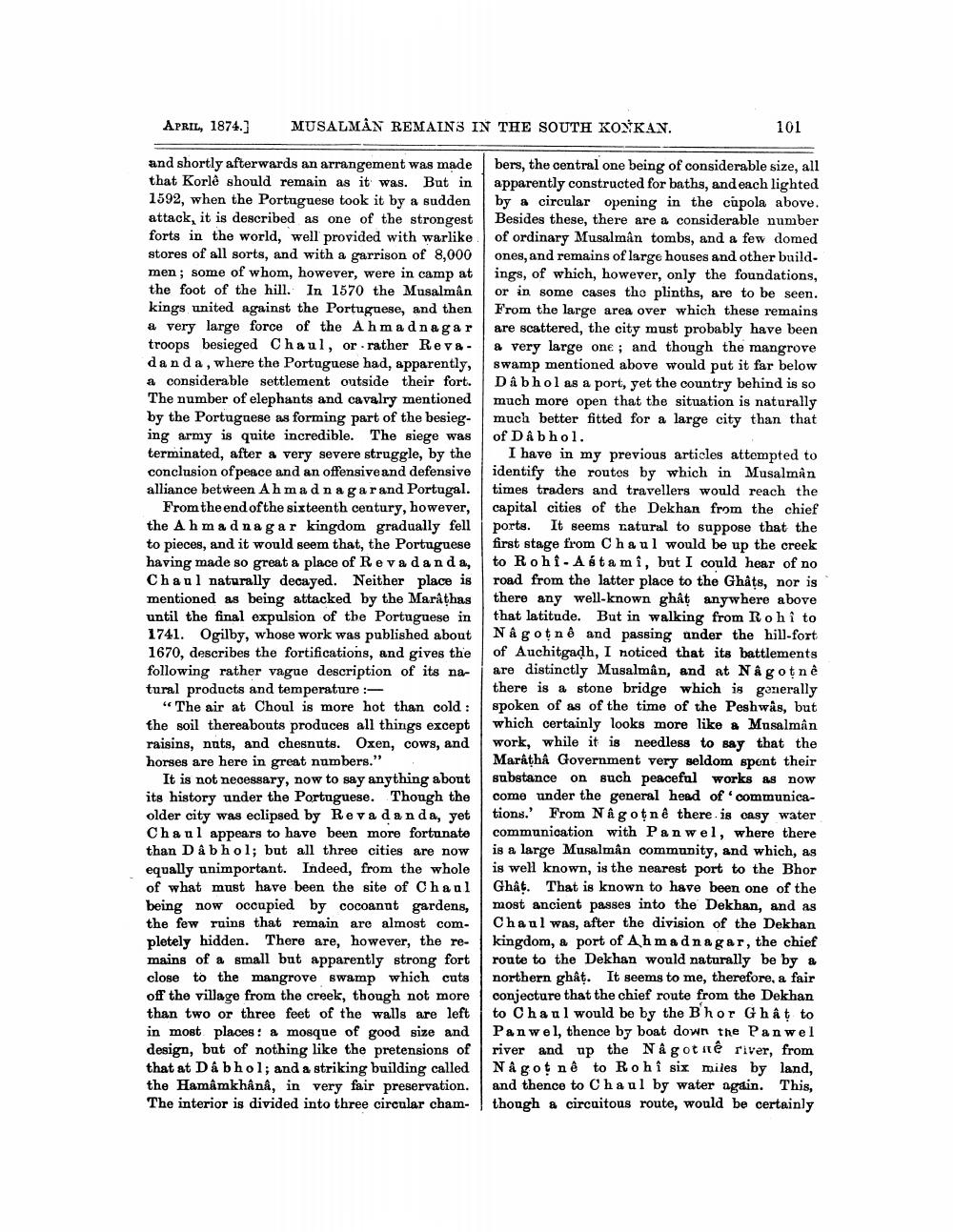________________
APRIL, 1874.)
MUSALMAN REMAINS IN THE SOUTH KONKAN.
101
and shortly afterwards an arrangement was made that Korld should remain as it was. But in 1592, when the Portuguese took it by a sudden attack, it is described as one of the strongest forts in the world, well provided with warlike stores of all sorts, and with a garrison of 8,000 men; some of whom, however, were in camp at the foot of the hill. In 1570 the Musalman kings united against the Portuguese, and then a very large force of the Ahmadnagar troops besieged Chaul, or rather Rev&danda, where the Portuguese had, apparently, a considerable settlement outside their fort. The number of elephants and cavalry mentioned by the Portugaese as forming part of the besieging army is quite incredible. The siege was terminated, after & very severe struggle, by the conclusion of peace and an offensive and defensive alliance between Ahmad na garand Portugal.
From the end of the sixteenth century, however, the Ahmadnagar kingdom gradually fell to pieces, and it would seem that, the Portuguese having made so great a place of Reva danda, Chaul naturally decayed. Neither place is mentioned as being attacked by the Marathas until the final expulsion of the Portuguese in 1741. Ogilby, whose work was published about 1670, describes the fortifications, and gives the following rather vague description of its natural products and temperature :
"The air at Choul is more hot than cold : the soil thereabouts produces all things except raisins, nuts, and chesnuts. Oxen, cows, and horses are here in great numbers."
It is not necessary, now to say anything about its history under the Portuguese. Thongh the older city was eclipsed by Reva danda, yet Chaul appears to have been more fortunate than Dabhol; but all three cities are now equally unimportant. Indeed, from the whole of what must have been the site of Chan1 being now occupied by cocoannt gardens, the few ruins that remain are almost completely hidden. There are, however, the remains of a small but apparently strong fort close to the mangrove swamp which cuts off the village from the creek, though not more than two or three feet of the walls are left in most places : a mosque of good size and design, but of nothing like the pretensions of that at Dá bhol; and a striking building called the Hamâmkhânâ, in very fair preservation The interior is divided into three circular cham-
bers, the central one being of considerable size, all apparently constructed for baths, and each lighted by a circular opening in the cupola above. Besides these, there are a considerable number of ordinary Musalman tombs, and a few domed ones, and remains of large houses and other buildings, of which, however, only the foundations, or in some cases the plinths, are to be seen. From the large area over which these remains are scattered, the city must probably have been a very large one ; and though the mangrove swamp mentioned above would put it far below Dabhol as a port, yet the country behind is so much more open that the situation is naturally much better fitted for a large city than that of DÅ bhol.
I have in my previous articles attempted to identify the routes by which in Musalman times traders and travellers would reach the capital cities of the Dekhan from the chief ports. It seems natural to suppose that the first stage from Chaul would be up the creek to Rohi. Asta mi, but I could hear of no road from the latter place to the Ghâts, nor is there any well-known ghat anywhere above that latitude. But in walking from Rohi to Någotnê and passing ander the hill-fort of Auchitgadh, I noticed that its battlements are distinctly Musalman, and at Någotnê there is a stone bridge which is generally spoken of as of the time of the Peshwas, but which certainly looks more like a Musalman work, while it is needless to say that the Marathi Government very seldom spent their substance on such peaceful works as now come under the general head of communications.' From Nâ gotnê there is oasy water communication with Panwel, where there is a large Musalman community, and which, as is well known, is the nearest port to the Bhor Ghat. That is known to have been one of the most ancient passes into the Dekhan, and as Chaul was, after the division of the Dekhan kingdom, a port of Ahmadnagar, the chief route to the Dekhan would naturally be by a northern ghat. It seems to me, therefore, a fair conjecture that the chief route from the Dekhan to Chaul would be by the Bhor Ghât to Panwel, thence by boat down the Pan wel river and up the Något ite river, from Någotnê to Rohi six miles by land, and thence to Chaul by water again. This, though a circuitous route, would be certainly




